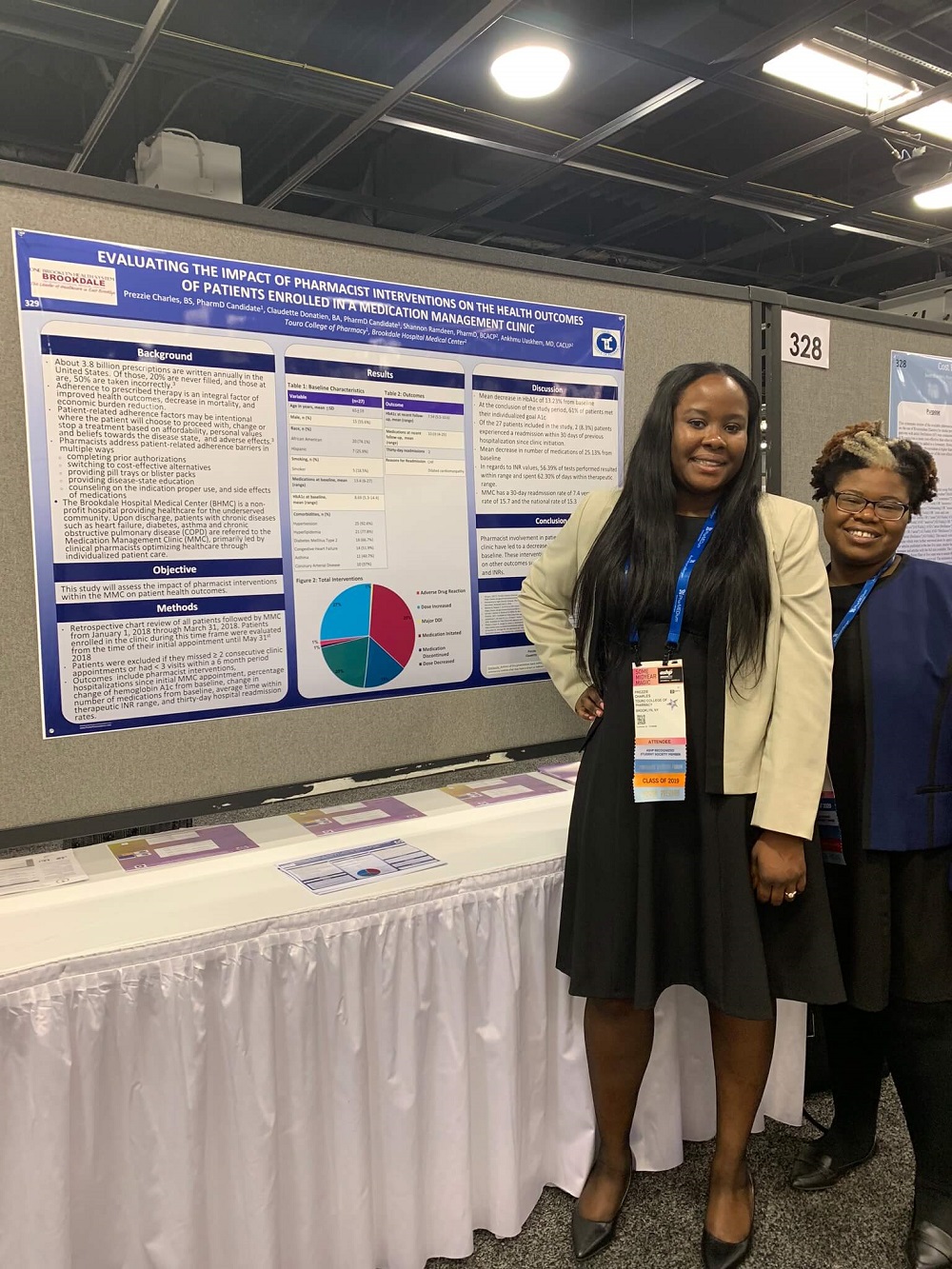A New Role for Pharmacists
Touro College of Pharmacy Student Presents on Pioneering Study That Reduces Hospital Re-Admittance

In an age of soaring medical costs, expensive hospital stays and unaffordable medications, a student at Touro College of Pharmacy (TCOP) evaluated a way to reduce all three.
Fourth year (P4) TCOP student Prezzie Charles, alongside P3 Claudette Donatien, presented their research, “Evaluating the Impact of Pharmacist Interventions on the Health Outcomes of Patients Enrolled in a Medication Management Clinic,” a poster presentation, at the American Society of Hospital Pharmacists (ASHP) mid-year conference in Anaheim, California on Dec. 2-6. In the poster, Charles, who spent a rotation last year at the Brookdale University Hospital Medical Center, reported the 30-day re-admittance rates for patients enrolled in the hospital’s medication management clinic (MMC) versus the rate of patients in general acute care who were discharged without being referred to the MMC. Patients with chronic diseases such as heart failure, uncontrolled diabetes, asthma and chronic obstructive pulmonary disease (COPD) can be referred to the MMC, an outpatient clinic, upon discharge, and the study followed those who were referred to MMC and those who weren’t. Patients in the medication management clinic had a dramatically lower hospital 30-day re-admittance rate than their counterparts who were released from general acute care without a referral.
“If a patient is on Medicare or Medicaid, a hospital may receive a penalty on reimbursements if a patient is readmitted to a hospital for any reason within 30-days of being discharged,” said Charles. “Through the managed care, we discovered that we not only lowered the rates of re-admittance, but we reduced the rates of the baseline of medications by 25 percent.”
The MMC is led by clinical pharmacists who work under a collaborative drug therapy management (CDTM) agreement. During each visit at the MMC, patients meet with clinical pharmacists who review their medications, create an individualized treatment plan for them, and order any medications and laboratory tests patients might need. Pharmacists also provided specialist referrals and monitored their various medical condition. A patient is followed by the MMC clinic until they are stabilized. In contrast, patients in general acute care were discharged with little or no follow-up after their hospital stay ended.
The current national 30-day readmission rate is 15.3 percent, Brookdale’s rate is slightly higher at 15.7 percent. Patients managed by the MMC in the study had a re-admittance rate of half that, 7.4 percent. Charles stated that the response to the presentation during the conference was positive.
“People had hypothesized about this, but most had never seen tangible data on it,” explained Charles. “Other pharmacists at the convention were able to see how a pharmacist could save hospitals millions of dollars while significantly improving patient outcomes. A single pharmacist can have an incredible impact.”
Dr. Zvi Loewy, TCOP’s associate dean of research, said that the school sent more than 40 students to the ASHP conference. “Having our students publicly present the projects they’ve worked on is a part of the education process,” said Dr. Loewy. “Charles’ work was unique in that it was a proactive intervention by a pharmacist and it showed how a pharmacist can make a difference in the quality of healthcare.”
In addition, Charles added, pharmacists were able to look at the cost of various medications and ensure that the patients could afford them. “If a patient arrives at an emergency room, a doctor will write them a prescription for a medication because it fits their profile without considering how much the medication costs,” said Charles. “Many times, impoverished patients are faced with a choice between paying rent and paying for medication. We were able to adjust the regimen, either by finding generic alternatives, finding savings programs or removing unnecessary medications so that our patients were able to afford their medications, improving compliance.”
Charles said that she knew she wanted to be a pharmacist ever since she was a teenager. “I walked into the pharmacy as a 14-year-old and I’ve been a technician ever since,” said Charles. Charles is a graduate of Touro’s New York School of Career and Applied Studies where she majored in biology with a minor in psychology, an undergraduate education in line with her beliefs about the role of a pharmacist.
“A pharmacist should have a connection to their patients,” said Charles. “I feel that the relationship is incredibly important. Many of our MMC patients were happy to come into the clinic to see us. They felt better about taking care of their health and that a pharmacist was there to help them every step of the way.”

